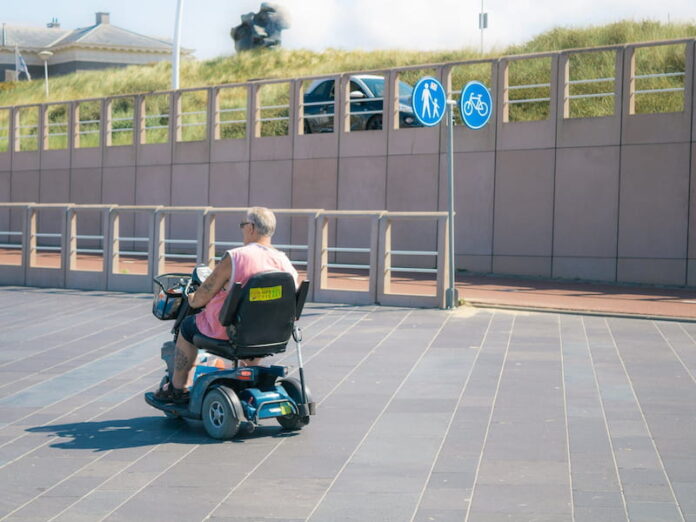Mobility scooters have experienced a significant surge in popularity in recent years as convenient aids for individuals requiring motorized assistance. While traditional scooters typically reach speeds of 4-5 mph, newer “high-speed” models enable users to swiftly navigate at 8-15 mph. Before selecting one of these agile scooters, it is paramount to take into account various factors such as speed, comfort, portability, safety features, and more.
Speed and Power
Although typical mobility scooters have a limited speed, fast mobility scooters can reach impressive top speeds of up to 15 mph, all thanks to their upgraded motors. The enhanced acceleration proves beneficial when merging into traffic, while the ability to climb hills aggressively allows you to conquer inclines without losing momentum. These higher speeds necessitate more robust motors, usually ranging from 800 to 2000 watts, in fast scooter models.
The compromise for velocity and acceleration is frequently battery range since higher speeds and stronger motors deplete batteries more rapidly. Therefore, assess whether your top priority is covering greater distances per charge cycle or swiftly moving between points A and B. Several scooter models provide users with the choice to switch between economy and turbo modes to achieve the optimal equilibrium. Check fast mobility scooters at Marc’s Mobility that boast a top speed of up to 15 mph to tackle any road with ease.
Comfort and Suspension
A smooth and comfortable ride is crucial, whether you’re heading to the local store or embarking on longer journeys. It all begins with an adjustable seat that enables you to find the perfect back support and height. Look for ergonomic seat designs that offer lumbar support and plush, breathable cushioning, ensuring pain-free sitting even during extended periods. In fact, certain models even feature heated seats for added comfort in cold weather conditions.
Suspension also plays a substantial role in ensuring a smooth ride for fast scooters. It allows them to effectively absorb bumps and maintain stability on uneven terrain. Both front and rear adjustable suspension systems enable riders to customize and achieve a stable and comfortable ride. The choice of tires is important to consider as well. Whether it’s air-filled or foam-filled tires with the right tread depth, they contribute to a vibrant yet less jarring passenger experience by flexing over obstacles.
Size, Weight and Portability
Scooter dimensions, foldability, and weight capacity require careful consideration based on your size, physical abilities, and usage plans. You should measure doorways, vehicles, elevators, and storage spaces that the scooter will need to navigate to ensure that the frame and turning radius are manageable. While heavier scooters offer more power for speed and hill climbing, they can weigh up to 159 lbs, which can make transportation difficult, especially if stairs are involved. Folding scooters provide the benefit of collapsing the frame and tucking the tiller for compact storage and easier loading onto vehicles, which is particularly advantageous for regular use away from home.
Consider load capacities, including both the support for the rider’s weight and the rear cargo racks designed for carrying extra baggage. Typically, the weight capacity for the rider ranges from 300 to 500 lbs, excluding any additional luggage, which should not exceed approximately 30 lbs. Before finalizing your decision, ensure that the chosen model can adequately handle your weight along with any gear you may have.
Safety Features
Enhanced speed capabilities necessitate additional safety precautions when operating a medical device. Scooter models approved for use on public roads must have appropriate exterior lighting, reflective components, and turn signals that activate for other motorists. Headlights improve visibility at night, while rear running lights, reflectors, and signals ensure clear communication of intentions when stopping or turning, allowing others to react accordingly.
Effective braking systems guarantee the capability to rapidly reduce speed. Numerous high-speed scooters use regenerative braking, which redirects power to the batteries while decelerating instead of wasting energy through heat dissipation. To ensure maneuverability during emergency stops at higher speeds, anti-lock brakes prevent tire lock-up. Adjustable speed capabilities should be considered, allowing for the limitation of top velocity settings to promote safer operation based on conditions and rider skill level.
Range and Charging
High-quality fast mobility scooters offer a range of up to 40 miles per charge, which is significantly greater than slower scooters. Determine if this range adequately meets your travel needs between charging sessions. If you frequently take long trips, consider exploring options for extending the scooter’s runtime, such as adding supplemental battery packs.
The charging time of electric scooters can vary significantly from one model to another, typically ranging from 2 to 12 hours. Ensure that the batteries have convenient access to external power sources through built-in charging ports. Proper maintenance of the batteries is crucial, including regular full discharges and charges, in order to prolong the optimal lifespan of the batteries.
Maintenance and Durability
Mobility scooters experience regular wear and tear from continuous use over various terrains. You should review reliability reports and durability assessments of fast scooter models that are being considered. It is not safe to assume that all brands offer the same level of longevity. Consumer research guides provide ratings on scooter lines for repair frequency and replacement part requirements, which can have a significant financial impact over years of ownership.
Effortless access to emblem components that occasionally require tune-ups is crucial. Steer clear of designs that necessitate complete frame disassembly and specialized tools to reach wheels, batteries, controllers, and lights, especially when only basic mechanical skills are available. Look for extended warranty coverage that offers peace of mind in case repairs are needed in the future. Aim for warranties of at least one year that cover the frame, electronics, batteries, and drive train.
Budget and Value
When comparing different models and brands of fast mobility scooters, consider the correlation between price and quality. While there are entry-level scooters available for approximately $1,000, midrange models with performance-oriented features typically range from $1,500 to $3,000. Deluxe high-speed scooters, on the other hand, start at around $3,500. Keep these price points in mind when assessing the features within your budget. Prioritize power, range, comfort, and durability rather than focusing solely on accessories that may not be essential.
When considering the upfront cost, account for ongoing ownership expenses that accrue over months and years of use. These expenses include incidental maintenance, repairs that fall outside the warranty coverage, periodic battery replacements, and the likelihood of desired upgrades. Review the projected operating costs and assess the overall value that scooters within your budget offer over their functional lifespan rather than solely fixating on the lowest price.
Conclusion
Mobility scooters offer a convenient way to travel and perform daily tasks with minimal physical effort, promoting independence. With fast models, you can cover more distance at speeds that rival traditional vehicle traffic. When choosing a mobility device, consider factors such as acceleration, battery range, comfort, portability, safety, and budget. You should gather comprehensive information about the models you’re interested in to ensure a smooth and enjoyable experience. Embrace the freedom of the open road as you feel the refreshing wind on your face, propelled by both motor and a sense of liberation.
Did you find this helpful? Check out our other helpful articles on our website.
Read Also
- Why the Keto Diet Works for Some People—and Fails Dramatically for Others: An Ayurvedic Breakdown for Modern HealthcareThe keto diet has dominated weight-loss culture for years. For some people, it produces rapid fat loss, stable energy, and improved mental clarity. For others—especially those who gain weight easily—it leads to burnout, digestive distress, rebound weight gain, high cholesterol, and a metabolism that feels slower than before. Healthcare often frames this as a discipline… Read more: Why the Keto Diet Works for Some People—and Fails Dramatically for Others: An Ayurvedic Breakdown for Modern Healthcare
- How to Choose the Best Assisted Living Facility for SeniorsAre you looking for the right assisted living facility for a senior loved one? Choosing a place can feel overwhelming. There are many factors to consider, from care services to the environment. Safety, comfort, and social opportunities play important roles in daily life. Each senior has unique needs and preferences that must be met. Understanding… Read more: How to Choose the Best Assisted Living Facility for Seniors
- Burn Smart, Not Hard; Shape Burn: Clean Protein for Weight ManagementYou want to feel light, strong, and confident. You don’t want crash diets or fake promises. You need a plan that works with your body, not against it. That’s where Shape Burn comes in. You can burn fat without losing strength. You can eat better and stay full. You can manage weight in a way… Read more: Burn Smart, Not Hard; Shape Burn: Clean Protein for Weight Management
- Creatine Basics: How Much Is 5g, How Much Water You Need, and Whether Pills or Powder Work BetterIf you’ve ever walked into a supplement aisle or scrolled through fitness TikTok, you’ve probably seen people talking about creatine — usually with a shaker bottle in hand and promises of better workouts and faster gains. And honestly? They’re not wrong. Creatine is one of the most researched and effective supplements for muscle strength, recovery,… Read more: Creatine Basics: How Much Is 5g, How Much Water You Need, and Whether Pills or Powder Work Better
- Understanding Breast Cancer in Men: Key Facts and SymptomsBreast cancer is often thought of as a disease that only affects women. However, men can develop it too. Although it is less common, early detection and awareness are important. Read on to learn key facts, symptoms, and ways men can take action to protect their health. How Common Is Breast Cancer in Men? Breast… Read more: Understanding Breast Cancer in Men: Key Facts and Symptoms
- Raising Awareness: Breast Cancer Facts for Older MenBreast cancer does not affect only women, and many older men do not realize they are at risk. Because the signs can be easy to miss, many men learn about the disease only when it has progressed. Learning the basic facts now can help you stay aware and respond early. If you want to protect… Read more: Raising Awareness: Breast Cancer Facts for Older Men
- How Regular Exercise Transforms Senior Living for the BetterGetting older is something everyone experiences, but how we age can be greatly influenced by the choices we make. One of the best ways for seniors to stay healthy, happy, and independent is through regular exercise. Staying active isn’t just about fitness-it can improve nearly every part of life. From building strength and energy to… Read more: How Regular Exercise Transforms Senior Living for the Better
- The Importance of Mammograms and Early Detection for Aging WomenAs women age, taking care of their health becomes even more important. One key part of women’s health is regular breast screenings. Mammograms are a simple but powerful tool that can detect breast changes early. Early detection can save lives by finding problems before they become serious. For aging women, staying informed and proactive about… Read more: The Importance of Mammograms and Early Detection for Aging Women









